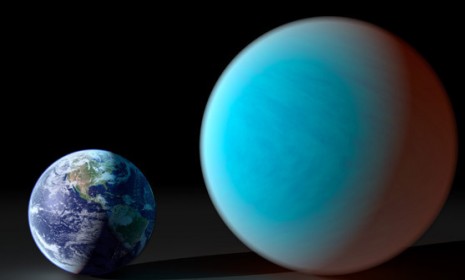The rare super-Earth made of diamond
40 light years away, astronomers have found a jewel of a planet

Can you say "bling bling?" Stargazing scientists at Yale can. They've discovered a rare super-Earth that approximates our planet's mass and radius, except for one big difference: Unlike our water-based planet, this one's made largely out of diamond. The world, inelegantly named 55 Cancri e, was first discovered in 2004, but it's only now that researchers have pinned down its diamond make-up. Here's what you need to know about the sparkly, strange new world:
Where is it?
The diamond planet is located a mere 40 light years from Earth. It orbits a binary star, 55 Cancri, alongside a handful of other planets. The star itself is so close "it is visible to the naked eye in the night sky," says Clara Moskowitz at Space.com. The diamond planet is a little bit bigger than Earth, with twice the radius and, due to its density, eight times the mass.
The Week
Escape your echo chamber. Get the facts behind the news, plus analysis from multiple perspectives.

Sign up for The Week's Free Newsletters
From our morning news briefing to a weekly Good News Newsletter, get the best of The Week delivered directly to your inbox.
From our morning news briefing to a weekly Good News Newsletter, get the best of The Week delivered directly to your inbox.
Why is it made out of diamonds?
The star system is primarily made of carbon, iron, and silicon, and over millions of years, 55 Cancri e's pressure and heat turned the planet's carbon mantle into diamond, says Sebastian Anthony at ExtremeTech. Yale researchers estimate that roughly a third of the planet's mass is made of pure diamond. That adds up to "a few trillion times more diamond than has ever been mined on Earth" — or a lot of wedding rings.
What's it like there?
With surface temperatures reaching 3,900 degrees Fahrenheit, the planet is probably unfit for life (or at least life as we know it). While previous studies posited that the planet has "supercritical fluids," new findings suggest it contains no water at all. And all that diamond could lead to "very different thermal evolution and plate tectonics processes than Earth," says Space.com's Moskowitz, "which could create bizarre types of volcanism, seismic activity, and mountain formation."
A free daily email with the biggest news stories of the day – and the best features from TheWeek.com
Is this new diamond world one of a kind?
Nope. A diamond planet roughly five times larger than Earth was discovered by Australian astronomers in 2011, about 4,000 light years away in the Serpens constellation. But unlike that discovery, 55 Cancri e is the first to orbit a sun-like star — and it might not even be the weirdest planetary possibility out there, says David Spergel, an astronomer at Princeton University. "The 'diamond-rich super-Earth' is likely just one example of the rich set of discoveries that await us as we begin to explore planets around nearby stars."
Sources: ExtremeTech, Reuters, Space.com
-
 Political cartoons for November 18
Political cartoons for November 18Cartoons Tuesday’s political cartoons include MTG's marching band, AI data centers, Trump's fat cat friends, and more
-
 What a rising gold price says about the global economy
What a rising gold price says about the global economyThe Explainer Institutions, central banks and speculators drive record surge amid ‘loss of trust’ in bond markets and US dollar
-
 ‘Laughing stock’: Anthony Joshua’s £140m bout with Jake Paul
‘Laughing stock’: Anthony Joshua’s £140m bout with Jake PaulTalking Point Boxing fans have expressed concerns the YouTuber may not survive the fight with British heavyweight